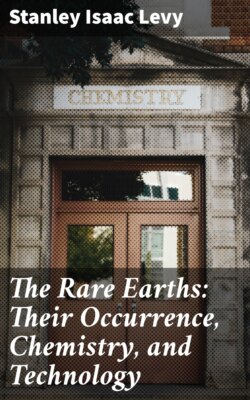Читать книгу The Rare Earths: Their Occurrence, Chemistry, and Technology - Stanley Isaac Levy - Страница 3
На сайте Литреса книга снята с продажи.
PREFACE
ОглавлениеTable of Contents
During the thirty years which have elapsed since Dr. Auer’s application of the rare earths to the production of artificial light, the incandescent mantle industry has developed to an extent which gives it a prominent place among those chemical industries which may be considered essential to modern civilisation. This technical development has in turn assisted and stimulated the scientific examination of the elements of this group, with the result that ordered and accurate knowledge is beginning to replace the confused and uncertain data which had been collected by earlier workers in the field. These advances have served to emphasise the scientific interest and importance of the rare earth group, and the difficulty of bringing it into relation with the other elements. The relatively scant attention devoted to the study of this province of inorganic chemistry by teachers and students in England is probably due no less to the difficulty in classification, and the uncertainty with regard to the homogeneity and individuality of the various members of the family—an uncertainty by no means entirely removed even now—than to the fact that the very extensive literature on the subject is somewhat confused and difficult of access, especially to those unfamiliar with the French and German languages.
The present work is intended to give a general but fairly comprehensive account of the rare earth group. In accordance with general usage, the elements zirconium and thorium have been included, though these are now recognised as falling outside the limits of the rare earth group proper. The inclusion of titanium, which chemically is so far removed from the cerium and yttrium elements, has been considered desirable, not only on account of its general occurrence in the rare earth minerals, and its position in Group IVB with zirconium, cerium, and thorium, but also on account of its increasing chemical and technical interest, and its use in the ordinary quantitative laboratory operations.
Though the nature of the matter embraced has rendered the division into three parts desirable, the whole subject has been treated primarily from the chemical standpoint. In view, however, of the occurrence of considerable quantities of monazite within the British Empire, and of the possibility that in the near future the Brazilian fields will not remain the sole source of thorium nitrate, stress has been laid on the technical aspect, which is more especially developed as regards the production of monazite and the incandescent mantle industry in Chapters VII and XVII-XX.
In the preparation of Part I full use has been made of Dana’s indispensable ‘System of Mineralogy,’ as well as of the encyclopædic ‘Handbuch’ of Hintze, whilst for Part II the excellent monograph of R. J. Meyer, in Abegg’s ‘Handbuch,’ Vol. III, Div. I, and the work of the same author and Hauser, ‘Die Analyse der seltenen Erden und der Erdsäuren,’ Vols. XIV-XV of ‘Die Chemische Analyse,’ have been of service.
I have great pleasure in expressing my gratitude to Mr. A. Hutchinson, of Pembroke College, Cambridge, who has kindly read for me the manuscript of Part I, and suggested improvements; to Dr. H. J. H. Fenton, of Christ’s College, who has given me similar assistance in Part II; and to Dr. S. Ruhemann, of Gonville and Caius College, who has read Parts II and III. I am also greatly indebted to Mr. E. J. Holmyard, of Sidney Sussex College, who helped me with the preparation of Part II; and to Mr. H. M. Spiers, of Gonville and Caius College, who read the proofs for me with special thoroughness and care.
I have also to thank Professor Soddy and his publishers, Messrs. Longmans, Green & Co., for kind permission to reproduce from ‘The Chemistry of the Radio-Elements’ the diagram on p. 138.
S. I. LEVY.
